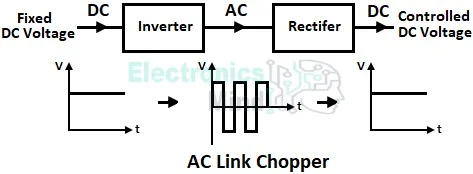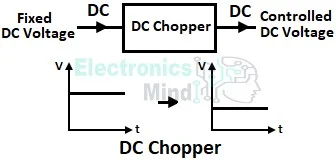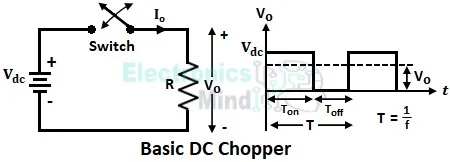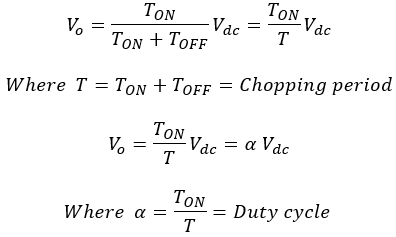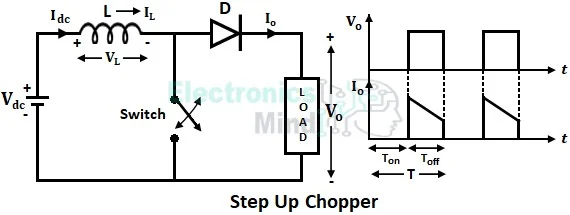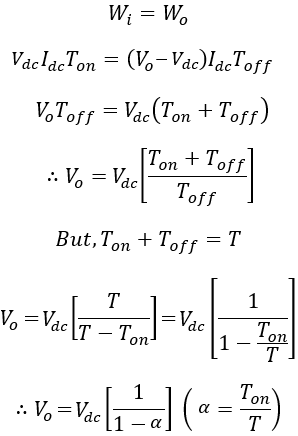Introduction :
Many domestic, industrial, automobile, lighting, traction, and space applications require power from dc voltage sources. For better performance and smooth control over the process, the equipment must be fed from a variable dc voltage source i.e., conversion of dc voltage to different levels is required.
Thus there is a need for a dc-to-dc converter by which an adjustable dc voltage source can be obtained from a fixed dc voltage source. Generally, the conversion of a fixed dc voltage to an adjustable dc voltage can be carried out by following techniques.
Resistance Controller :
It is the simplest method of dc-to-dc conversion in which a variable resistance is used between the load and the dc supply source. By changing the value of variable resistance the dc voltage supplied to the load is controlled. Though it is the simplest method it is power-inefficient due to the losses in the series resistor.
Motor-Generator Set :
In this type of dc-to-dc conversion technique, two dc machines of similar ratings are used. In the two machines, one operates as the motor and the other as the generator. A fixed dc voltage is applied to the dc motor, the motor converts the dc supply into mechanical energy, and then the mechanical output from the dc motor is applied to the dc generator.
The dc generator converts the mechanical energy into electrical energy where the output will be a variable dc voltage. Since this type of conversion technique requires two machines, the whole system is bulky, costly, and less efficient.
AC Link Chopper :
In an ac link type dc-to-dc chopper, the available fixed dc voltage is converted into ac by using an inverter circuit. Then after the ac output from the inverter is fed to a transformer where the voltage is stepped up or stepped down according to the requirement.
The output voltage from the transformer is then again converted into dc voltage by using a rectifier circuit. In this way, a variable dc voltage is obtained using an ac link chopper. The below figure illustrates the conversion process of an ac link chopper.
In the whole operation of the above ac link chopper, we can see that it involves two stages where dc is converted into ac and ac is again converted into dc. However this type of conversion technique requires a high cost due to the requirement of a transformer, rectifier, and inverter circuit, it is inefficient due to multiple stages and the circuit becomes bulky.
DC Chopper :
A dc chopper is a semiconductor switch (ON-OFF switch) that connects and disconnects the dc supply to the load at a rapid rate to obtain variable dc voltage from a fixed dc voltage source.
Compared to ac link choppers, dc-to-dc conversion is directly done in dc choppers without any multiple stages. Thus a dc chopper can be considered as a dc equivalent of an ac transformer that can either step up or step down a fixed dc voltage source.
As dc choppers involve single-stage conversion they are more efficient, low in cost, have faster response, lower maintenance, and are smaller in size. Therefore dc choppers are widely used in most applications where there is a requirement for variable dc voltage supply.
The power semiconductor switches used in dc choppers are power BJT, power MOSFET, IGBT, GTO, or force-commutated thyristor. For low and medium power applications power MOSFET, IGBT or BJTs are used as the switches. Thyristor-based dc choppers are used in high-power applications, also this type of chopper circuit requires an additional commutation circuit. However, thyristors are not preferred nowadays due to the complexity of the circuit configuration.
Working Principle of DC Chopper :
We have seen that a dc chopper is simply an ON-OFF switch that connects and disconnects the dc supply to the load. The below figure shows the basic dc-to-dc chopper circuit which consists of a semiconductor switch connected between the dc supply (Vdc) and load (R).
Now when the switch is closed, the load gets connected across the dc voltage source and when the switch is opened, the load doesn’t receive any power from the dc source. In this manner, the switch is closed and opened at a fast rate so that the dc voltage source reaches the load in pulse form. From the above figure, the average output voltage Vo is given by,
Therefore, the average dc voltage Vo supplied to the load is controlled by controlling the duty cycle (α) of the switch i.e., the average dc output voltage Vo of the chopper depends upon the turn-ON and turn-OFF periods of the switch.
Here TON can vary from 0 to T, so 0 ≤ α ≤ 1. Thus output voltage Vo can be varied from 0 to Vdc. Since the output voltage obtained is lesser than the input voltage this type of chopper circuit is called a step-down chopper.
However, dc choppers can also produce an output voltage greater than the input voltage (i.e., Vo > Vdc). This type of dc chopper circuit is called a step-up chopper and is illustrated below.
In a step-up chopper, a large inductor is connected in series with the dc source. When the switch is closed, the inductor stores energy in it, and the load is disconnected from the source. When the switch is opened inductor current doesn’t drop suddenly, thus the load is fed with a voltage that is the sum of the inductor voltage (L(di/dt)) and the source voltage (Vdc).
The power supplied to the inductor when the switch is closed is given by,
Now when the switch is OFF, the power released by the inductor to the load is given by,
Considering no losses in the system, in the steady-state Wi = Wo.
Here TON can vary from 0 to T, so 0 ≤ α ≤ 1. Thus output voltage Vo can be varied from Vdc to ∞, hence the output voltage obtained will be higher than the input voltage.
Generally, two techniques are used to control the output voltage of a dc chopper. They are,
- Pulse-width modulation or constant frequency operation.
- Frequency modulation or variable frequency operation.
In pulse-width modulation, the average output voltage is controlled by varying the ON period of the switch at a constant switching frequency (i.e., constant chopping period T = TON + TOFF).
In frequency modulation, the switching frequency is varied (i.e., chopping period T = TON + TOFF is varied) by varying either the turn-ON or turn-OFF period of the switch. But this technique generates harmonics at unpredictable frequencies due to which the filter design becomes complex. This method is generally used when a forced-commutated thyristor is used as the switch.
Types of DC Choppers :
DC choppers are classified based on the value of output voltage, the direction of output voltage and current, and the commutation method used. The various types of dc chopper circuits are listed below.
- Based On Output Voltage,
- Step-up chopper
- Step-down chopper
- Based On Direction of Output Voltage and Current,
- Class A (type-A) chopper
- Class B (type-B) chopper
- Class C (type-C) chopper
- Class D (type-D) chopper
- Class E (type-E) chopper
- Based On Commutation Method,
- Voltage commutated chopper
- Current commutated chopper
- Load commutated chopper.
Advantages of DC Chopper :
- DC choppers are more efficient compared to other types of dc-to-dc converters like resistance controllers, motor-generator sets, and ac link choppers.
- DC chopper circuit offers smooth control over the output voltage.
- The use of power semiconductor switches makes a dc chopper circuit have a fast response.
- They are smaller in size and require less space.
- It requires less maintenance.
- Less cost compared to moto-generator set and ac link chopper.
- They have less weight.
Applications of DC Chopper :
- DC choppers are used in subway cars, trolley buses, and battery-operated vehicles.
- DC choppers can offer regenerative braking of dc motors, resulting in energy saving.
- Used in speed-controlling of dc motors.
- The unregulated dc voltage from solar photovoltaic cells can be regulated using dc choppers.
- Chopper circuits are used in switched-mode power supplies, onboard regulated dc power supplies, and various domestic and commercial electronic appliances.
- Airplanes and spaceships.

